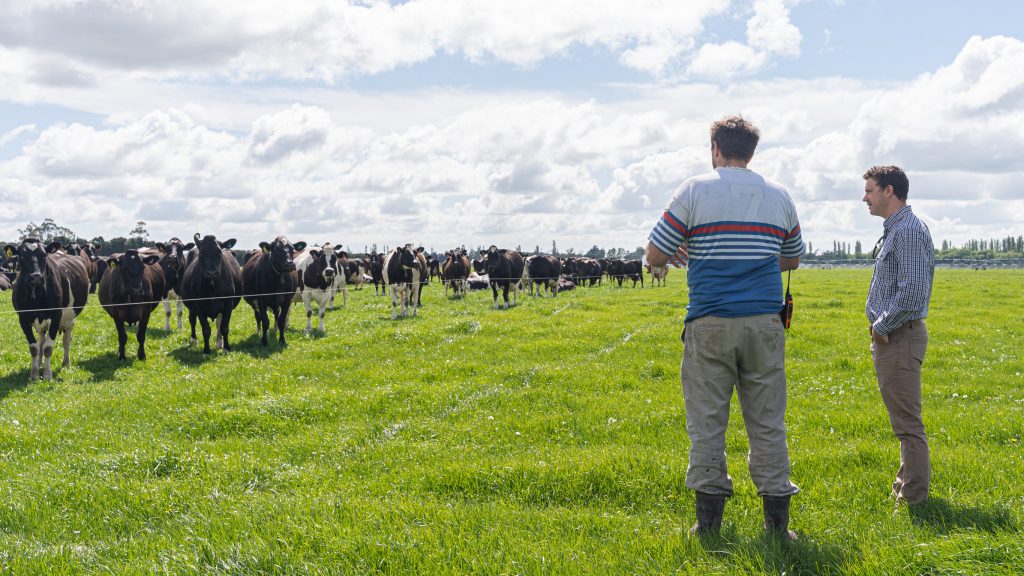The importance of a well-functioning rumen for transition is especially emphasised in New Zealand’s diverse climatic and grazing conditions. Due to our reliance on a majority pasture-based system, transition diets experience a massive shift in composition as they move into high-energy spring grasses.
Modern grass cultivars are the least obvious yet often the most potent drivers of sub-acute ruminal acidosis in New Zealand. These grasses are highly digestible, often lack sufficient fibre, and are very high in soluble sugar which acts as rocket fuel for rumen microbes. The sugars are rapidly broken down into acids that radically alter the pH of the rumen. In these lower pH environments, pathogenic bacteria become dominant and endotoxins are generated. This type of acidosis is termed sub-acute because, unlike lactic acidosis, it is less visible – it doesn’t kill the cow quickly or dramatically. Further into lactation, if the SARA is not too acute, it can simply make the cow sick without affecting production. If the cow is pregnant, the endotoxins produced can enter the uterus and destroy the newly-developing fetus. It can also lead to lameness (white line disease), mastitis, and other immune related diseases.
Cows with sub-optimal rumen function, caused by SARA, in early lactation are at higher risk of metabolic disorders, such as ketosis, as well as reduced feed conversion efficiency and poorer energy utilisation. Clinical signs may include ketotic breath odour, lethargy, leaning, or decreased rumen contractions upon examination.
The importance of a well-functioning rumen in transitioning dairy cows cannot be overstated, as it underpins their metabolic health, productivity, and resilience to New Zealand’s environmental challenges.
Recognising when a transitioning dairy cow’s rumen is not functioning correctly is crucial for early intervention and prevention of more serious health issues. There are multiple key indicators of rumen dysfunction that vets, nutritionists, and dairy farmers need to be able to recognise and act upon quickly to minimise negative impacts to cow health and productivity.
Decreased dry matter intake
A sudden decrease in feed consumption or appetite can be a sign the rumen isn’t functioning well. Transitioning cows may be hesitant to eat if they’re experiencing discomfort or metabolic imbalances associated with rumen dysfunction.
Changes in manure consistency
Manure is an exceptionally helpful tool when monitoring rumen efficiency. Changes to its consistency, such as diarrhoea or loose stools, as well as the presence of undigested feed may indicate disruptions in process of fermentation and nutrient absorption. Conversely, constipation or reduced manure can also signal motility issues is the rumen.

Reduced rumen fill
Vets can physically examine cows to assess rumen fill and motility. A decrease in rumen size or abnormal rumen contractions may suggest impaired rumen function.
Symptoms of acidosis
Sub-acute ruminal acidosis (SARA) is a common rumen disorder during transition, characterised by low rumen pH levels. Symptoms of SARA include decreased chewing, foul breath, diarrhoea, and laminitis. Vets may also recognise signs of discomfort, such as pawing, kicking at the belly, or lying down frequently.
Decrease in milk production
Reduced milk yield or changes in milk composition (e.g., decreased fat or protein content) may indicate inadequate nutrient supply or inefficient rumen fermentation. Monitoring individual cow milk production and component levels can help identify rumen-related issues.
Abnormal behaviour
Transitioning cows experiencing rumen dysfunction may exhibit abnormal behaviours, such as restlessness, aggression, or isolation from the herd. Monitoring behaviour during feeding, resting, and within the herd can provide valuable insights into rumen health.
Changes to body condition scores
Changes in body condition score (BCS) can be a sign of nutritional imbalances or energy deficits associated with rumen dysfunction. Vets monitoring BCS regularly are able to intervene quickly to prevent further loss or gain of body condition.
How does mineral supplementation support a healthy rumen?
Probably the most successful strategy in preventing SARA in pasture fed cows is to introduce a rumen buffer. In the past, sodium bicarbonate (baking soda) has been used, however, due to its solubility, sodium bicarbonate tends to transit the rumen too quickly giving only short-termrelief. More recently, mineral buffers have been used. These stay in the rumen for much longer periods (five to seven hours), and are far more successful at buffering the rumen throughout the entire grazing period.
Live yeasts have also been shown to successfully support rumen function, as the primary digesters of fibre increasing the yeast levels in ruminants can play an important role in stabilising rumen activity.
Good mineral supplementation can also be a factor in successfully balancing rumen performance. Macro minerals and essential trace elements play vital roles in ensuring good ruminal function, particularly during the transition period.
Macro minerals such as calcium, phosphorus, magnesium, potassium, and sodium are essential for maintaining rumen pH, enzyme function, and overall metabolic processes. Additionally, trace minerals like copper, zinc, manganese, selenium, and iodine serve as cofactors for enzymes involved in rumen fermentation and metabolisation of nutrients. To ensure springers receive adequate levels of these minerals, a balanced diet containing mineral supplements tailored to meet their specific requirements is crucial.
Conducting regular herbage analyses on all feed components gives valuable insight into nutrient and mineral content in the diet, and will alert to any potential imbalances that need to be addressed.
With New Zealand’s varying weather patterns, subsequent environmental challenges, and reliance on grass as the main feed source, our springers are at increased risk of suboptimal rumen function and the resulting health and productivity impacts. By recognising signs of rumen dysfunction early on, vets, nutritionists, and dairy farmers can work together to take corrective action and mitigate the severity of impacts to the cow’s metabolic health.




